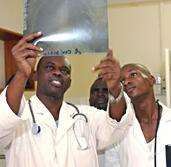KAMPALA, Uganda -- Earlier this month, 1,000 people from around the world gathered at a World Health Organization-sponsored forum here to discuss what's increasingly being seen as a global crisis: the acute shortage of health care workers. The WHO estimates that more than four million health care workers are needed in the 57 countries it defines as grossly understaffed (fewer than 2.3 doctors, nurses and midwives per 100,000 people). Thirty-six of the 57 worst-hit countries are in Africa (Malawi has around 265 doctors for 12 million people; Zambia has about 650 for the same population). But when it comes to actual population, Asia is the most affected by the dearth of health care personnel. According to WHO figures, Asia requires 3 of the 4 million health care workers required to bridge the human resource gap. But with aging populations, the health care worker shortfall in industrialized countries, while much less severe than that of Southeast Asia or Africa, is also driving up the demand for trained hospital and clinic staff. According to Judith Oulton, the CEO of International Council of Nurses in Geneva, Switzerland, the United States will need 800,000 nurses by 2015.
Migration, Governance at Root of Global Shortage of Health Care Workers

